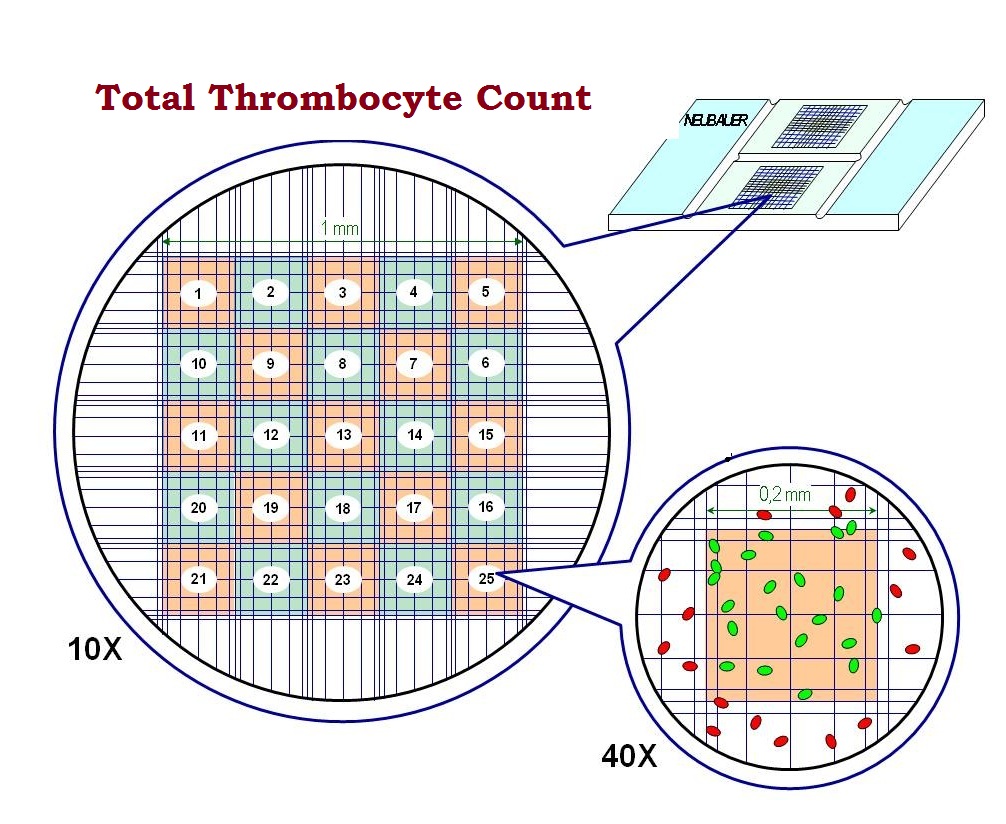
Principle
- Total platelet count ek blood test hai jo blood mein platelets (thrombocytes) ki quantity measure karta hai.
- Platelets blood clotting aur wound healing ke liye bahut important hote hain.
- Ye count usually automated blood cell analyzer se ya manual hemocytometer se kiya jata hai.
- Is process mein blood sample dilute karte hain aur microscope ya automated machine ke zariye platelets count karte hain.
- Ye batata hai ki ek microliter (µL) blood mein kitne platelets hain.
Requirements
-
Whole blood EDTA
-
Hemocytometer (counting chamber)
-
Pipettes
-
Glass slides
-
Cover slips
-
Microscope
-
Diluting fluid:
-
Procaine – 3.0 g
-
Sodium hydrochloride – 10 g
-
Distilled water – 100 ml
-
Procedure
-
Diluting fluid prepare karo.
-
Blood sample ko dilution fluid ke saath known ratio mein dilute karo.
-
RBC pipette use karke blood ko 0.5 mark tak draw karo.
-
Pipette ke bahar extra blood wipe kar do.
-
Diluting fluid 101 mark tak draw karo (blood dilute hota hai 1:200).
-
Bulb mein achhi tarah mix karo.
-
5 minute ke baad pehla drop discard karo, phir chhota drop counting chamber ke ek side par transfer karo.
-
Mounted counting chamber ko petri dish ke upar rakho jisme moist filter paper ho. 15 minute tak undisturbed rehne do.
-
Counting chamber ko microscope ke stage par carefully rakho. Low power magnification par red cell counting area focus karo.
-
Red cell area ke chamber square ko dekho aur high-power objective par switch karo.
-
Condenser ko neeche rakho aur diaphragm adjust karke light kam karo.
-
Platelets highly refractile particles jaise dikhai denge.
-
Saare 25 chhote squares mein platelets count karo. Ye 25 squares ka area 1 square mm ke barabar hota hai.
-
Calculation:
Total platelet count nikalne ke liye formula use karo:
Platelet count (per µl) = Number of platelets counted × Dilution / Volume of fluid
Normal Range
Normal platelet count: 150,000 se 450,000 platelets per microliter (µL) blood.
Clinical Significance
Low Platelet Count (Thrombocytopenia):
Platelet count: 150,000 platelets/µL se kam.
Causes:
-
Bone marrow disorders (jaise leukemia, aplastic anemia)
-
Autoimmune diseases (jaise lupus, immune thrombocytopenic purpura [ITP])
-
Viral infections (jaise dengue, HIV)
-
Drug-induced (jaise heparin-induced thrombocytopenia)
-
Blood loss ya dilution (jaise massive transfusion ke baad)
-
Liver diseases (jaise cirrhosis)
Symptoms:
-
Bleeding ka risk badhna (aasan bruise hona, petechiae, gums se bleeding)
-
Injury ya surgery ke baad bleeding zyada hona
High Platelet Count (Thrombocytosis):
Platelet count: 450,000 platelets/µL se zyada.
Causes:
-
Reactive (secondary) thrombocytosis infections, inflammation, ya iron deficiency ke karan
-
Essential thrombocythemia (myeloproliferative disorder ka ek type)
-
Chronic myelogenous leukemia (CML)
Symptoms:
-
Blood clot banne ka risk badhna, jiski wajah se stroke, deep vein thrombosis (DVT), ya pulmonary embolism ho sakta hai
-
Kabhi kabhi bina symptoms ke bhi ho sakta hai, par kuch cases mein headache, dizziness, ya vision disturbance ho sakte hain
Monitoring Disease Progression and Treatment:
Platelet count ko use kiya jata hai monitor karne ke liye:
-
Cancer treatments (chemotherapy, radiotherapy) jo platelet production ko affect karte hain
-
Liver cirrhosis jahan platelet count disease progression ko show karta hai
-
Bone marrow disorders mein platelet count changes treatment ke response ko indicate karte hain